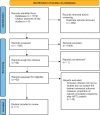How common is natural conception in women who have had a livebirth via assisted reproductive technology? Systematic review and meta-analysis
- PMID: 37339780
- PMCID: PMC10391314
- DOI: 10.1093/humrep/dead121
How common is natural conception in women who have had a livebirth via assisted reproductive technology? Systematic review and meta-analysis
Abstract
Study question: What is the proportion of women who experience natural conception after a livebirth via assisted reproductive technology (ART)?
Summary answer: Current evidence suggests that natural conception pregnancy may occur in at least one in five women after having a baby via IVF or ICSI.
What is known already: It is widely known that some women having babies via ART go on to conceive naturally. This reproductive history is of media interest and often described as 'miracle' pregnancies.
Study design, size, duration: A systematic review with meta-analysis was carried out. Ovid Medline, Embase, and PsycINFO were searched until 24 September 2021 for English language, human studies from 1980. Search terms were used for the concepts of natural conception pregnancy, assisted reproduction, and livebirth.
Participants/materials, setting, methods: The inclusion criterion was studies with an outcome measure of the proportion of women experiencing natural conception pregnancy after an ART livebirth. Quality of studies was assessed using the Critical Appraisal Skills Programme cohort study checklist or AXIS Appraisal tool for cross-sectional studies, and a risk of bias assessment was carried out. No studies were excluded based on quality. Random-effects meta-analyses were adopted to produce a pooled effect estimate of the proportion of natural conception pregnancy after ART livebirth.
Main results and the role of chance: A total of 1108 distinct studies were identified, resulting in 54 studies after screening by title and abstract. Eleven studies including 5180 women were selected for this review. The included studies were mostly of moderate quality with a maximum follow-up period ranging from 2 to 15 years. Four studies reported natural conception livebirths which were used as known underestimates of natural conception pregnancies. The pooled estimate for the proportion of women having natural conception pregnancies after ART livebirth was 0.20 (95% CI, 0.17-0.22).
Limitations, reasons for caution: The studies varied widely according to methodology, population, cause of subfertility, type and outcome of fertility treatment, and length of follow-up, leading to potential bias relating to confounding, selection bias, and missing data.
Wider implications of the findings: Current evidence suggests that contrary to widely held views, natural conception pregnancy after ART livebirth is far from rare. National, data-linked studies are needed to provide more accurate estimates of this incidence and analysis of associated factors and trends over time to facilitate tailored counselling of couples considering further ART.
Study funding/competing interest(s): This work was conducted as part of an academic clinical fellowship awarded to AT by the National Institute for Health Research (NIHR). NIHR has had no input into the study design, data collection, and analysis, nor the writing of this study. No authors have any conflicts of interest.
Registration number: PROSPERO (CRD42022322627).
Keywords: ARTs; ICSI; IVF; infertility; live birth; meta-analysis; systematic review.
© The Author(s) 2023. Published by Oxford University Press on behalf of European Society of Human Reproduction and Embryology.
Conflict of interest statement
No authors have any conflicts of interest.
Figures



Similar articles
-
Age-related natural fertility outcomes in women over 35 years: a systematic review and individual participant data meta-analysis.Hum Reprod. 2020 Aug 1;35(8):1808-1820. doi: 10.1093/humrep/deaa129. Hum Reprod. 2020. PMID: 32696041
-
Using serum anti-Müllerian hormone levels to predict the chance of live birth after spontaneous or assisted conception: a systematic review and meta-analysis.Hum Reprod. 2023 Sep 5;38(9):1789-1806. doi: 10.1093/humrep/dead147. Hum Reprod. 2023. PMID: 37475164
-
Cumulative live birth rate prognosis based on the number of aspirated oocytes in previous ART cycles.Hum Reprod. 2019 Jan 1;34(1):171-180. doi: 10.1093/humrep/dey341. Hum Reprod. 2019. PMID: 30541039
-
In vitro fertilization and multiple pregnancies: an evidence-based analysis.Ont Health Technol Assess Ser. 2006;6(18):1-63. Epub 2006 Oct 1. Ont Health Technol Assess Ser. 2006. PMID: 23074488 Free PMC article.
-
Prioritizing IVF treatment in the post-COVID 19 era: a predictive modelling study based on UK national data.Hum Reprod. 2021 Feb 18;36(3):666-675. doi: 10.1093/humrep/deaa339. Hum Reprod. 2021. PMID: 33226080 Free PMC article.
Cited by
-
Fertility preferences adjusted: reimagining parenthood in response to the uncertainty of infertility.Genus. 2025 May 13;81(1):s41118-025-00248-1. doi: 10.1186/s41118-025-00248-1. Genus. 2025. PMID: 40391068 Free PMC article.
References
-
- Anonymous. I had an abortion after years of infertility.Stella Magazine, 2020. https://www.telegraph.co.uk/women/life/spent-years-trying-conceive-had-a....
-
- Barrett DG. The London Measure of Unplanned Pregnancy (LMUP), 2022. http://www.lmup.com/ (accessed 17 August 2022).
-
- Bernstein D, Levin S, Amsterdam E, Insler V.. Is conception in infertile couples treatment-related? A survey of 309 pregnancies. Int J Fertil 1979;24:65–67. - PubMed
-
- Birenbaum-Carmeli D, Dirnfeld M.. In vitro fertilisation policy in Israel and women's perspectives: the more the better? Reprod Health Matters 2008;16:182–191. - PubMed
-
- Buzzfeed. Chrissy Teigen Told the Story of How She Found Out She Was Pregnant in a Lengthy Twitter Thread and Wow, What a Ride, 2020. https://www.buzzfeed.com/shylawatson/chrissy-teigen-discovered-third-pre... (accessed 17 August 2022).
Publication types
MeSH terms
Grants and funding
LinkOut - more resources
Full Text Sources
Medical
Research Materials

